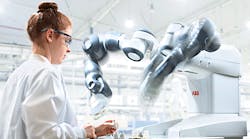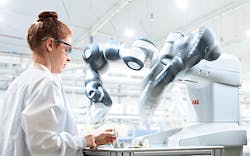In an interview with Per Vegard Nerseth, he talks about ABB's new robot manufacturing facility, and its nontraditional YuMi robot.
First, can you tell us a bit about ABB?
We’re a company with $40 billion turnover and 140,000 employees all around the world, but what we do is very simple: power and automation for utilities, industry, and transportation.
Our strategy is very simple. We want to help our customers accelerate sustainable value creation. Our goal is to provide unmatched engineering, innovative products, and flawless service and support to our customers. We call it the “Next Level” strategy and our mission is to take our customers, and ABB, to the next level of profitability and growth.
If you look at the fields of power and automation where we’re active today, it’s a fantastically exciting environment because we see a fundamental paradigm shift in both the power and industrial value chains. On the power side, we call it the “big shift” in power. Renewables will be more than 35% of the global installed capacity in 15 years. Renewables will mean more volatility, less predictability, more complexity. And that’s great for us as a technology leader.
On the industrial side, we developed the first automation capabilities with electric motors 124 years ago and have been a global leader in automation for many years. And today, we’re fully embracing the fourth industrial revolution where things, services, and people are connected through the Internet in a way never seen before. We’re cutting waste out of supply chains, improving up-time and reliability, and increasing the speed of operations through better synchronization. And we’re able to provide this at lower cost because communication bandwidth is available in an abundance as it has never been before.
How does robotics fit into this strategy?
Robotics is a key pillar of our automation portfolio and a fundamental enabler of industrial growth in an increasingly competitive world. Our robot business will play a key role to safeguard the competitiveness of our North American customers, drive productivity, add jobs, and create wealth and competitiveness. And that’s why ABB is the first global automation company to open a robot manufacturing facility in the United States.
The new factory complements our existing plants in Sweden and China. It will shorten lead times and lets us serve U.S. customers in a much more agile way. And being closer to customers gives us an even better understanding of their issues and needs. It also means more investment in R&D and local value chains, expands our education and training capabilities and will increase our workforce in the plant to around 1,000 employees in the years to come.
Is the robot market growing?
Since 2009, we have seen tremendous growth; 2013 and 2014 were record years and the global robot market grew by 25% last year. Not many industrial segments can match that kind of growth. We’re thrilled about that and there are great opportunities ahead.
What’s behind the demand?
There are several trends. One is that the use of robots now gives an ROI that makes them more accessible to more potential end users than some years ago. Also, the new generation of customers better understands the capabilities of robots. Today, robotics is taught in schools and universities, there are numerous competitions, even Lego is making robots. That results in a better overall understanding of what can be done. It’s much different versus the highly specialized expertise needed 30 or 40 years ago.
Driven by technology, new types of robots are easier to work with and are moving beyond conventional applications in the automotive industry. Today, we’re seeing increasing demand for nontraditional robots, say for bakeries or for assembling mobile phones and laptops, where requirements for payload and reach are much smaller.
Finally, the market is more receptive to robots as a key to higher productivity. Around the world, people are more educated and it is increasingly difficult to find workers willing to do the dangerous, delicate, dirty, and dull jobs that they did in the past. Even in China, where you assume millions are looking for work, they don’t want to sit at a workstation and perform the exact same task over and over, 10 hours a day.
In such cases, our new robot YuMi is a great fit. It can perform the same operation, hundreds of thousands of times, every time with an accuracy of 0.02 mm. There’s no human being who can match that speed, accuracy, and consistency.
Can you tell us more about YuMi?
YuMi is really quite special. It represents ABB’s newest technology and is a breakthrough in robotics. YuMi is a collaborative, dual-arm industrial robot that can safely work alongside humans without the need for a protective cage.
It has human-like size and movements and features flexible hands, integrated grippers, a vision system, and precise motion control. And it is inherently safe. For instance, it can sense an unexpected collision with a coworker, pause its motion within milliseconds, and then quickly restart.
While YuMi was specifically designed to meet the flexible and agile production needs of the consumer electronics industry, it has equal application in many other small-parts assembly environments. With the introduction of YuMi, ABB is once again pushing the boundaries of robotic automation by fundamentally expanding the types of industrial process tasks robots can perform.
How does YuMi compare to other collaborative robots?
YuMi was designed to work alongside people all the time, with no barriers, no cages, and no virtual zones required. It is the world’s first truly collaborative robot and can operate in permanent collaborative mode, unlike other robots which require the use of virtual zones and have to be operated at much slower speeds than YuMi in collaborative mode.
Collaborative robots are still a relatively small niche. But their use is growing at a fairly high rate and they will soon represent a significant market segment. As more and more players enter the market, it will help expand the understanding of what collaborative robots can do.
How do robots fit into the concept of Industry 4.0, or the Internet of Things?
Industry 4.0, connecting people, services, and things together through serial communications has really been under development for some time. We can now generate, transmit, and manage vast amounts of data and send that information instantly to another part of the world. For example, YuMi has an IP address and can be fully connected via the Internet to our remote service centers.
This file type includes high resolution graphics and schematics when applicable.
The possibilities of Industry 4.0 are exciting. We use software tools not only for programming, but for engineering, planning, installation, and commissioning. And we can remotely monitor how a robot is operating, improve performance and efficiency, diagnose problems, and minimize downtime. That said, cybersecurity is a critical consideration and being granted access to customers’ facilities is something we do not take lightly. We’ve had good success in this respect, but it’s definitely one of the challenges as we move ahead.



